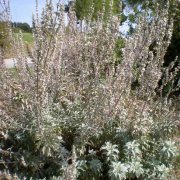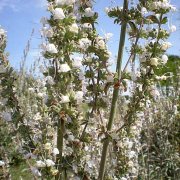Care of the plant Salvia apiana or White sage |
|
The genus Salvia, family Lamiaceae, comprises 1,000 species of shrubs and herbaceous plants native to Asia, Africa, the Mediterranean region, and Central and South America. Some species are: Salvia apiana, Salvia africana, Salvia scabra, Salvia lanceolata, Salvia canariensis, Salvia farinacea, Salvia leucantha, Salvia guaranitica, Salvia namaensis, Salvia greggii, Salvia microphylla, Salvia mexicana, Salvia splendens, Salvia disermas, Salvia vaseyi, Salvia leucophylla, Salvia verbenacea, Salvia sclarea, Salvia mellifera, Salvia nemorosa, Salvia officinalis, Salvia aurea, Salvia fruticosa, Salvia elegans, Salvia x sylvestris. Common names: White sage, Sacred sage, Bee sage. This species is native to California. They are slow-growing aromatic subshrubs with brittle stems that reach 1 meter (3.28 feet) in height when they flower. The leaves are lanceolate, with a serrated edge and green, covered with hairs that give it a silver tone. The flowers are white and appear in long inflorescences above the foliage. They bloom in spring. White sage is used in rockeries, in gardens of aromatic plants, to cover slopes, in pots and planters and in flowerbeds and borders. It's a honey plant that attract bees. Salvia apiana prefers full sun exposure but also grows in semi-shade. It resists the heat of the Mediterranean summer and the occasional frost. It's important that the soil is very well drained and contains organic matter. Water moderately, waiting until the substrate has completely dried. In winter Bee sage keeps up with the rains. Fertilize with compost in late winter. Prune wilted flower stems and prune intensively in late fall. If the humidity is excessive Salvia apiana is attacked by Oidium or by Rust. Sometimes it can be attacked by snails, slugs, whiteflies or aphids. White sage is propagated from seeds sown in spring or by semi-woody cuttings. |
Images of the plant Salvia apiana or White sage |
Find plants
Salvia apiana or White sage | Care and Growing
© 2025 FavThemes






